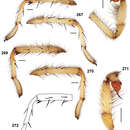Description
provided by Zookeys
Specimen preparation and condition. Specimen collected live, wandering, preserved in 80% EtOH. Coloration and specimen in relatively good condition. Pedipalp, leg I left side removed, stored in vial with specimen; legs right side removed for tissue storage. General coloration. Carapace, chelicerae, yellowish brown 10YR 5/4. Abdomen light yellowish brown 10YR 6/4, light dorsal chevron markings (Fig. 273). Cephalothorax. Carapace 5.75 long, 5.05 wide, very hirsute with intermingled thin white, black setae; stout black bristles along fringe; surface smooth, pars cephalica elevated. Fringe, posterior margin lacks black bristles. Foveal groove deep, straight. Eyes elevated on low mound. AER slightly procurved, PER strongly recurved. PME’s smaller in diameter than AME’s. Sternum moderately setose, STRl 3.10, STRw 2.67. Posterior sternal sigilla moderate in size, positioned towards center, not contiguous, anterior sigilla pairs small, oval, marginal. Chelicerae with distinct anterior tooth row comprising 7 teeth, posterior margin with patch of small denticles. Palpal endites with patch of small cuspules on proximal, inner margin, labium lacks cuspules, LBw 0.97, LBl 0.65. Rastellum consists of 3 spines not on prominent mound. Abdomen. Setose, heavy black setae intermingled with fine black setae. Legs. Legs long; Leg I: 6.88, 5.19, 4.35, 2.88, 1.90; leg IV: 6.19, 3.05. Tarsus I, swollen distally, tarsus IV straight. Heavy short scopulae on tarsi I, II; lighter on legs III, IV. Tarsus I with single, slightly staggered row of 13 trichobothria. Leg I spination pattern illustrated in Figures 266, 267, 269, 270, 272; TSp 4, TSr 4, TSrd 3. Knob-like metatarsal apophysis bearing a single large spine. Pedipalp. Articles slender (Fig. 268), distal prolateral spine on tibia (Fig. 271). PTw 0.85, PTl 2.57, Bl 1.45. Embolus slender, tapering sharply toward tip, lacking serrations (Fig. 271).
Variation (2). Cl 5.25-5.75, Cw 4.70-5.05, STRl 3.10-3.13, STRw 2.57-2.67, LBw 0.90-0.97, LBl 0.56-0.65, leg I: 6.38-6.88, 4.70-5.19, 4.15-4.35, 2.67-2.88, 1.75-1.90; leg IV: 5.88-6.19, 2.92-3.05; PTl 2.38-2.57, PTw 0.85-0.85, Bl 1.45-1.53, TSp 2-4, TSr 4-4, TSrd 3-6.
- bibliographic citation
- Bond J (2012) Phylogenetic treatment and taxonomic revision of the trapdoor spider genus Aptostichus Simon (Araneae, Mygalomorphae, Euctenizidae) ZooKeys 252: 1–209
- author
- Jason E. Bond
Distribution
provided by Zookeys
Aptostichus sinnombre is known from only two specimens from the Anza-Borrego Desert State Park, Colorado Desert habitat, in San Diego County and is sympatric with Aptostichus anzaborrego. Males appear to disperse during late winter months (February, March), based on the limited data available.
- bibliographic citation
- Bond J (2012) Phylogenetic treatment and taxonomic revision of the trapdoor spider genus Aptostichus Simon (Araneae, Mygalomorphae, Euctenizidae) ZooKeys 252: 1–209
- author
- Jason E. Bond

